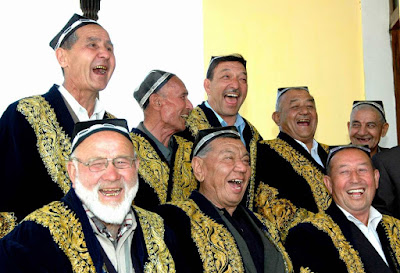 |
| Askiya participants enjoying their own gags |
It was added to UNESCO's Representative List of the Intangible Cultural Heritage of Humanity in late 2014.
Bearers and practitioners, mainly men, must master the peculiarities of the Uzbek language, and be able to improvise and reason quickly and skilfully, using humour and banter to great effect. (Women did practise askiya in the past, however, it is rare today).
The dialogues, although humorous, play an invaluable role in raising awareness of social tendencies and events, drawing attention to important issues through acute observation of daily life.
Askiya is often performed in folk celebrations, festivities, family-related rituals and get-togethers organized in cities and villages across Uzbekistan. At present, more than thirty forms of Askiya are known, some professional and some amateur, each with its own distinctive features. It is most widespread in the Ferghana Valley - in Andijan, Namangan and Ferghana. To a lesser extent it is practised in Tashkent and Bukhara.
 |
| Audience enjoying an askiya competition, Ferghana |
Askiya promotes humour, ensures simplicity of communication among people, and unites representatives of different communities, irrespective of age and background, around a common event. It also has a strong educational component.
(As an aside, the local bazaar, near the hotel where Uzbek Journeys clients stay in Tashkent, is called Askiya bazaar).
Below is a 10-minute UNESCO video clip highlighting askiya. Sadly the subtitles are a little blurry. However, the genial nature of Uzbeks and their delight in good puns and jokes, makes it worth watching.
Related posts: Manaschi - Bards of Kyrgyzstan
Uzbek Divas: Capturing the Poetic Traditions of Central Asia